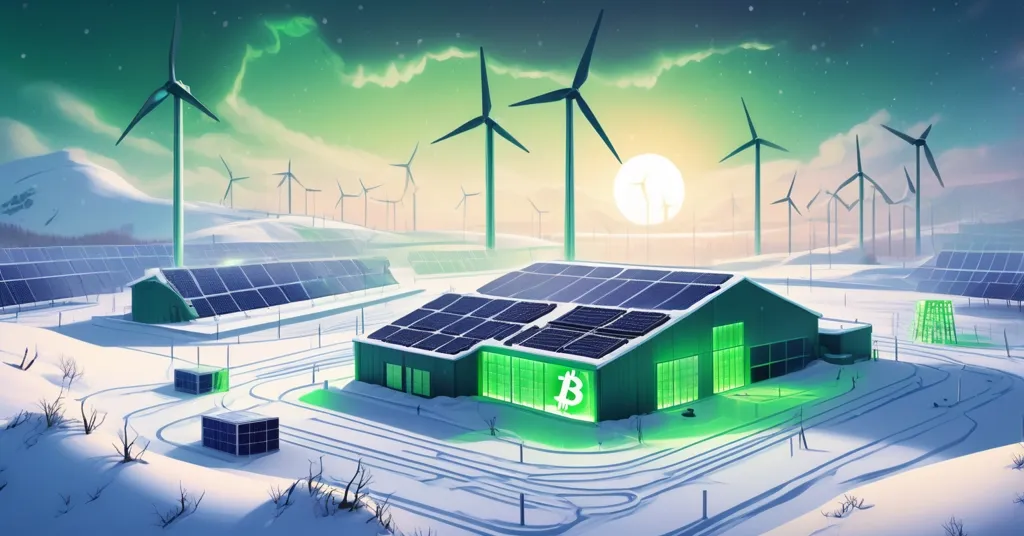Kevin O’Leary and Bitzero Lead Bitcoin’s Green Mining Revolution to Solve Energy Crisis

Green Mining Reset: Kevin O’Leary and Bitzero Tackle Bitcoin’s Energy Crisis
Bitcoin mining has been slammed for guzzling energy like a runaway freight train, but a hard pivot toward sustainability is shaking things up. Shark Tank’s Kevin O’Leary, alongside Bitzero CEO Mohammed Bakhashwain, is driving this change, pitching a future where green mining isn’t just a buzzword—it’s a profitable necessity. In a candid chat with Cryptonews, they lay out how power infrastructure, surplus energy, and institutional hunger are rewriting the rules of the game.
- Green Surge: Over 52% of Bitcoin mining now taps sustainable energy, with Bitzero leading the pack.
- Power Play: Bitzero focuses on energy infrastructure, juggling Bitcoin mining with AI and high-performance computing demands.
- Institutional Wave: O’Leary predicts a tidal wave of demand if Bitcoin becomes a portfolio staple like gold.
Bitcoin’s Energy Problem: A Carbon Credit Card Debt
For years, Bitcoin mining has been the poster child for environmental excess, often powered by coal-heavy grids in places like China before its 2021 crypto crackdown. The backlash was fierce, and deservedly so—mining rigs chewing through electricity painted the industry as a planet-killer. But the tide is turning. A study from the Cambridge Centre for Alternative Finance (CCAF) shows that 52.4% of Bitcoin mining now runs on sustainable energy, a leap from 37.6% in 2022. Renewables like hydropower and wind account for 42.6%, with nuclear chipping in 9.8%. Natural gas, at 38.2%, has shoved coal (down to 8.9%) aside as the top single source, especially in North America, which hosts over 80% of reported mining activity.
Yet, let’s not pop the champagne just yet. CCAF pegs Bitcoin’s annual electricity use at 138 terawatt-hours (TWh)—about 0.5% of global consumption, or roughly the yearly draw of a mid-sized nation like Argentina. Its carbon footprint? A hefty 39.8 million tons of CO2 equivalent (MtCO2e). That’s not pocket change; it’s a full-blown climate debt. With Bitcoin’s price spikes drawing more miners and institutional eyes, the pressure to clean up is non-negotiable. Sustainability isn’t just a feel-good move—it’s survival as regulators and the public demand accountability. For a deeper look at the environmental impact, check out this detailed overview on Bitcoin’s energy consumption.
Bitzero’s Green Fix: Mining Without the Mess
Enter Bitzero, founded in late 2020, a company that’s less obsessed with Bitcoin’s price rollercoaster and more with building the engine room of the crypto revolution. Backed by O’Leary—aka “Mr. Wonderful” for his Shark Tank bite—they’re all about power infrastructure. Their operations span Scandinavia with sites in Finland (scalable to 1 gigawatt, enough to power roughly 750,000 homes, over 5-6 years) and Norway (a 300-megawatt capacity). They’ve also secured a Cold War-era military base in North Dakota for grid-independent ops, a nod to energy sovereignty that screams decentralization. Their game plan? Use surplus electricity in remote areas to mine without hiking local household bills or stressing community grids. Learn more about their sustainable operations in Scandinavia.
“Our assets are power envelopes. Right now, AI demand is strongest, and with traditional tech hubs facing shortages, we’re seeing rising interest in remote regions like ours,” says Mohammed Bakhashwain, Bitzero’s CEO.
Bitzero isn’t chained to Bitcoin mining alone. They’re agnostic, steering energy to wherever demand peaks—be it crypto or the exploding fields of AI and high-performance computing (HPC). Right now, AI data centers are hogging the spotlight due to power shortages in places like Silicon Valley. But their setup lets them flip the switch as needs shift, positioning them as a dual-threat in a compute-hungry world. Beyond that, they’re not just mining coins—they’re recycling heat into greenhouses for winter produce and training locals for data center jobs, showing green mining can have a human face. Measurable impacts like reduced CO2 or job creation stats are still sparse, but the intent is clear: don’t screw over the little guy. For more on their infrastructure, see this report on Bitzero’s green mining efforts.
“We want to be as people-friendly as possible. That’s why we focus on areas where our consumption doesn’t raise household costs,” Bakhashwain emphasizes.
O’Leary’s Money Moves: Infrastructure Over Hype
Kevin O’Leary brings a cold, hard investor’s eye to the crypto chaos. He’s capped his personal crypto stake at 20% of his portfolio, with Bitcoin holding a core “granddaddy position” of 3-5%—a sweet spot he reckons most investors should aim for. But he’s not just sitting on digital gold waiting for moonshot prices. He’s chasing yield, something Bitcoin doesn’t naturally offer since it pays no dividends or interest like stocks or bonds do. For insights into his perspective, explore this exclusive interview with O’Leary on sustainable mining.
“Bitcoin is my granddaddy position – it’s a perpetual holding. Three to five percent is the right allocation for most investors. But Bitcoin doesn’t pay distributions, and that’s what I’m solving for now; finding ways to create yield on my Bitcoin holdings,” O’Leary reveals.
He’s eyeing financial wizardry and regulatory openings like the Genius Act to craft “royalties” on Bitcoin—think passive income akin to stock dividends. It’s a juicy idea for anyone tired of hodling without cash flow. But O’Leary’s real bet is on infrastructure. Why just own Bitcoin when you can own the machinery that mints it?
“My investment strategy in any asset class is to own the infrastructure as well as the asset itself. If you’re going to own Bitcoin, why not own the picks and shovels that make it happen? That’s power, that’s energy, that’s data centers. Bitzero checks all those boxes,” he argues.
He’s onto something. Turning surplus energy into Bitcoin, like at Bitzero’s Norway site where hydroelectricity rules, is like bottling value forever. It’s not just mining—it’s pushing compute efficiency forward for everyone.
“When a coin is created from surplus electricity, as in Bitzero’s Norway site, it’s capturing the value of that energy in perpetuity. It’s pushing compute forward and making it more efficient for everybody,” O’Leary notes.
Halving Hell: Efficiency or Bust
Bitcoin mining isn’t a carefree cash grab. Every four years or so, the network’s halving event slashes block rewards—basically cutting miners’ paychecks in half. The 2024 halving dropped rewards to 3.125 BTC per block, and historically, events like the 2020 halving have crushed weaker players who couldn’t adapt. It’s a brutal squeeze on margins, making efficiency the only path to survival. Bitzero claims their older rigs still turn a profit through relentless upgrades and operational tweaks, a testament to their focus on optimization over reckless growth.
Let’s not forget the 2022 bear market bloodbath. Over-leveraged miners, drowning in debt and bad decisions, collapsed like cheap tents in a storm. O’Leary sees it as a brutal but necessary purge, clearing the deck for sharper operators like Bitzero to step up. Post-halving economics are a meat grinder—only the tough and smart survive.
Institutional Gold Rush: The 5% Trigger
Here’s the big kicker: institutional adoption could be Bitcoin’s rocket fuel. O’Leary points out that 95% of institutions have zero crypto in their portfolios. The few who’ve dipped in are playing it safe with ETFs or treasury stocks like MicroStrategy. If Bitcoin locks in as a legit alternative asset class—think digital gold—why wouldn’t they toss in 5% of their trillions? The demand would be astronomical, spiking both price and the need for sustainable mining setups. Curious about O’Leary’s broader views on crypto? See this discussion on his involvement in the space.
“If crypto becomes just another alternative asset class like gold, why wouldn’t institutions put 5% of their portfolios in it? The demand could be massive,” O’Leary muses.
But barriers loom large. Regulatory uncertainty, wild price swings, and a lack of trusted custodial solutions keep most big players on the sidelines. Plus, they’re watching the energy debate closely—nobody wants to back a dirty asset. Green mining isn’t just a nice-to-have; it’s the key to unlocking those deep pockets. And here’s a Bitcoin-maximalist nudge: unlike altcoins chasing niche gimmicks, Bitcoin’s unmatched security and first-mover status make it the prime candidate for institutional trust. Altcoins have their place in pushing boundaries, but Bitcoin is the bedrock.
The Dark Side of Green: Hype or Real Fix?
Green mining sounds like a fairy tale fix, but let’s play devil’s advocate. Is it scalable, or just a niche trick? Surplus energy in remote Scandinavia works for Bitzero, but can it cover Bitcoin’s global appetite? Critics warn of greenwashing—slapping a “sustainable” label on operations while the broader 39.8 MtCO2e footprint lingers. And while nuclear power, already at 9.8% of mining energy per CCAF, could be a game-changer with near-zero emissions, it’s bogged down by sky-high costs and regulatory red tape. Natural gas, dominant in the U.S. at 38.2%, is cleaner than coal but still a fossil fuel—hardly a long-term hero. For a deeper dive into these issues, check out this analysis of sustainable Bitcoin mining challenges.
Then there’s policy risk. U.S. and EU energy regulations could clamp down on mining if grids strain or political winds shift. Bitzero’s off-grid North Dakota setup is a middle finger to centralized control, embodying crypto’s rebel spirit, but not every miner can pull that off. Green mining is progress, no doubt, but it’s not a silver bullet. That carbon stain won’t vanish overnight, and pretending otherwise is just bad math. Join the conversation on platforms like Reddit for community takes on green mining.
Powering the Future: Where Do We Stand?
Bitcoin mining isn’t the eco-villain it once was, but it’s no saint either. Bitzero and O’Leary are proving you can mine green and still make bank, even with halving events turning the screws. Their bet on power infrastructure—spanning Bitcoin to AI—feels like a glimpse of a broader tech upheaval where compute is king. Institutional interest could send the space into overdrive, but only if sustainability keeps up and regulators don’t kill the vibe. For now, that 138 TWh energy bill and 39.8 MtCO2e tab remind us the road is long. Green mining might be Bitcoin’s lifeline—but only if we quit dreaming and start digging into real, scalable solutions. For additional context, read this in-depth interview with O’Leary on the paradigm shift in mining.
Key Takeaways on Sustainable Bitcoin Mining
- What’s fueling the shift to sustainable Bitcoin mining?
Environmental criticism, regulatory heat, and institutional demand for clean-mined Bitcoin are pushing the industry. Bitzero taps surplus energy in remote spots to cut impact while meeting investor standards. - How does Bitzero balance Bitcoin mining with AI and HPC?
They stay flexible, funneling power to the highest demand—currently AI due to shortages in tech hubs. Their setup allows quick pivots between sectors as markets shift. - What pain does Bitcoin halving inflict on miners?
Halvings slash rewards, gutting profits. Bitzero fights back with upgrades and efficiency to keep older rigs viable, a must in a cutthroat post-2024 landscape. - Why is institutional adoption a big deal for Bitcoin?
With 95% of institutions still out, a mere 5% portfolio slice could unleash massive demand, boosting Bitcoin’s value and the push for green mining infrastructure. - How can investors squeeze yield from Bitcoin?
Bitcoin offers no natural payouts, but O’Leary is chasing products and policies like the Genius Act to generate “royalties” or income from holdings. - Can green mining truly fix Bitcoin’s environmental crisis?
It’s a solid step—52.4% sustainable energy is progress—but scaling surplus power globally is tough, and a 39.8 MtCO2e footprint lingers. It’s not a full cure, just a strong start.



